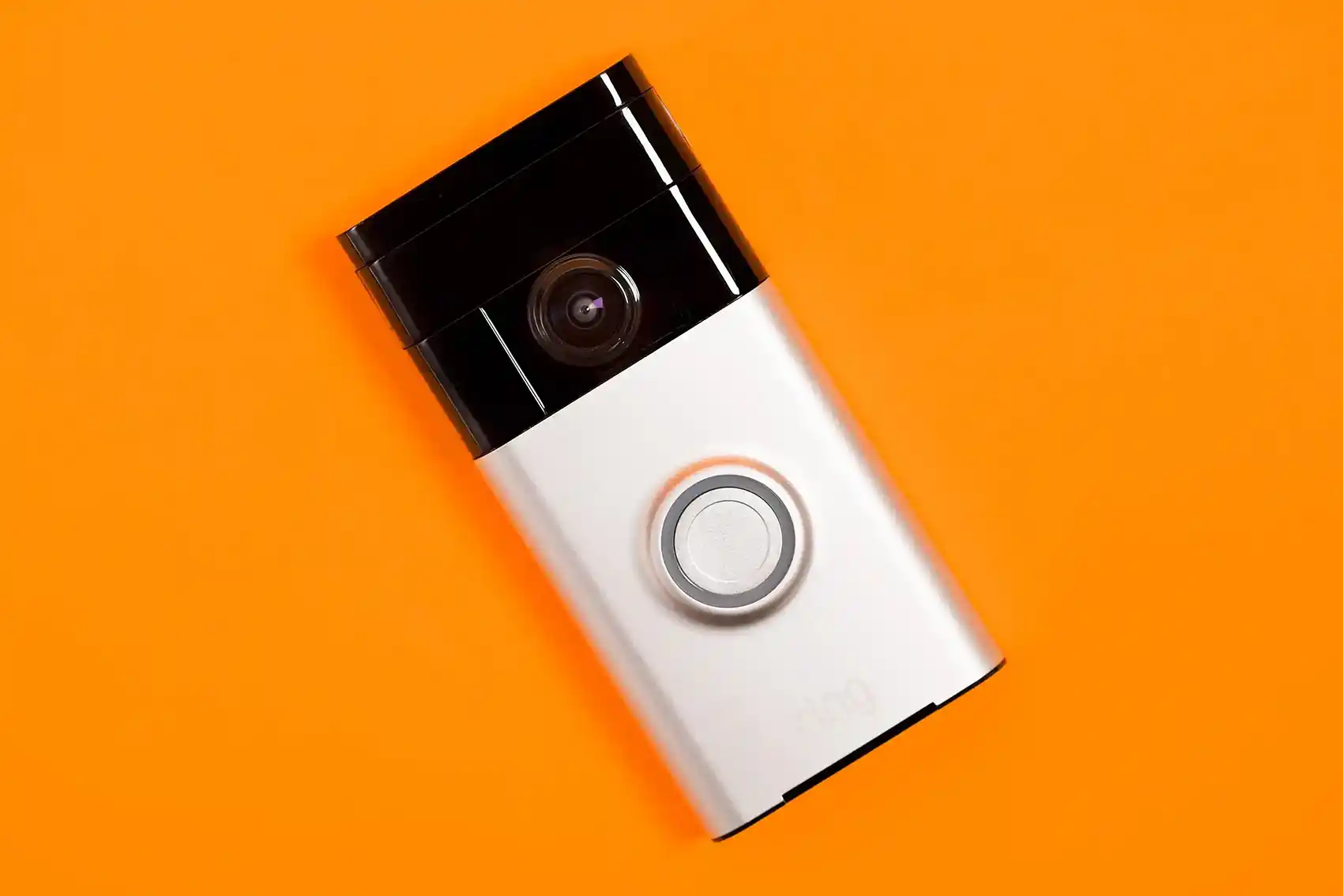
Should Ring Doorbell Be On 2.4 or 5 GHz?
Ring doorbells primarily use WiFi for connectivity. 2.4 GHz offers wider coverage but at slower speeds, while 5 GHz provides faster speeds with shorter range. Most Ring doorbells require a 2.4 GHz WiFi connection to function properly, but some are “dual band” devices that can work on both wavelengths. 2.4 GHz is typically more stable and has a longer range, which makes it better when the Ring is far from your router. 5 GHz is usually faster, but shorter range, so the doorbell must be close to the router or you’ll need a WiFi extender.
2.4 GHz can penetrate walls and floors more easily, extending the signal over a larger area. This makes it better for devices that don’t require high bandwidth. But it’s more prone to interference from other household devices like gaming consoles and wireless phones using the same frequency.
5 GHz is significantly faster, making it ideal for high-bandwidth tasks like streaming video. But it has a shorter range and poor obstacle penetration compared to 2.4 GHz. Less devices use it so there’s less interference, but its reach may not extend to all corners of a larger home.
For Ring doorbells, the better choice is usually 2.4 GHz. Ring doorbells don’t require the high data rates that 5 GHz provides. Their primary function is to send notifications, live video feeds, and recorded clips, which 2.4GHz can handle.
Doorbells are typically installed on exterior walls, sometimes far from the router. 2.4 GHz is more likely to maintain a stable connection over a greater distance and through walls.
I’ve been working in property management for over 15 years and use Ring doorbells on all our locations. While 5 GHz is faster, the range and reliability of 2.4 GHz makes it the best choice in most cases.

Pros & Cons of 2.4GHz vs. 5 GHz for Ring Doorbell
When selecting the best Wi-Fi frequency for your Ring Doorbell, understanding the distinct advantages and limitations of the 2.4 GHz and 5 GHz bands is important.
Your choice impacts the device’s performance, range, and reliability in everyday use.
2.4 GHz Pros & Cons
The 2.4 GHz frequency has a longer range, making it better when the signal must travel through solid barriers such as walls and floors. This is especially beneficial for Ring Doorbells that are installed long distances from the router.
The signal strength remains stable even when obstacles are present, like an exterior wall.
The 2.4 GHz band also has widespread compatibility among a plethora of Wi-Fi-enabled devices. This includes modern smart home gadgets and older devices that may not support the 5 GHz frequency. This universal compatibility ensures that a variety of devices can integrate with your Ring Doorbell without worrying about a frequency mismatch or the need for additional, potentially costly hardware upgrades.
The 2.4 GHz band faces some challenges concerning congestion and data transmission rates. In many households, numerous devices and appliances, ranging from gaming consoles to baby monitors, operate on the same 2.4 GHz frequency.
This crowded environment can create significant interference, disrupting the Wi-Fi signal and the performance of devices like Ring Doorbells that rely on a steady connection.
The 2.4 GHz band provides lower data speeds compared to its 5 GHz counterpart. This limitation becomes apparent during tasks that demand high bandwidth, such as video streaming.
When a Ring Doorbell shares the 2.4 GHz band with multiple devices in a home, the competition for bandwidth can degrade the quality of its video feed, leading to a less clear or interrupted view, which might compromise the very security functions it’s meant to perform.
5 GHz Pros & Cons
The 5 GHz frequency band can support higher data rates, an important factor for the performance of devices like Ring Doorbells that transmit high-definition video feeds. With the ability to send faster data transmissions, the 5 GHz band provides a smoother, more seamless video quality with minimal buffering.
The 5 GHz spectrum is less congested compared to the widely used 2.4 GHz band. A smaller number of household devices operate within this frequency range, diminishing the potential for interference. This can be better in apartments with lots of competing signals and devices.
This is particularly advantageous in maintaining a stable connection, crucial for continuous, real-time video streaming or communication with visitors.
By reducing the likelihood of signal interference, the 5 GHz band promotes a more reliable and consistent connection for Ring Doorbells, enhancing the overall functionality and user experience of the device.
Two of the primary drawbacks of 5GHz is limited range and the inability to penetrate solid objects. This means the 5 GHz signal often struggles to maintain strength over longer distances or through barriers like walls and floors.
The issue of device compatibility is another problem with the 5 GHz frequency. Unlike the 2.4 GHz band, not all Ring models are equipped to operate on the 5 GHz spectrum. This restriction can be a problem when multiples devices need to function cohesively.
Households that incorporate a mix of older and newer technology might find that some devices are unable to connect to the 5 GHz network, necessitating a dual-band approach or limiting the ability to implement a higher-speed frequency across all devices. This not only complicates network management but could impede the seamless integration and functionality that smart home ecosystems want to achieve.
Recommendations
The 2.4 GHz frequency is recommended for most Ring Doorbell installations due to its extensive range and better obstacle penetration. It’s particularly advantageous in larger properties or houses with several walls between the doorbell and the router, ensuring consistent connectivity.
The 5 GHz frequency is best if your Ring Doorbell is relatively close to your router, and you desire higher video quality, especially for models like the Ring Pro or Elite. It’s suitable for smaller homes or environments where the doorbell is within a clear line of sight to the router, ensuring a robust connection for streaming high-bandwidth content.
The ideal choice depends on your specific home layout, device compatibility, and video quality requirements. Assess your space, check your device specifications, and choose the frequency that best suits your circumstances for a secure, reliable, and functional Ring Doorbell experience.
What Is Ring Doorbell Default WiFi Setting?
Ring doorbells are typically set to 2.4 GHz WiFi by default because this is the most common router frequency used in homes.
The 2.4GHz frequency band provides a longer range and better signal penetration through walls and other structures. This ensures that the device can maintain a stable connection even when placed outside the house or at a considerable distance from the router.
This is crucial for maintaining the reliability of notifications and video streaming that Ring doorbells provide.
If you want to change to the 5GHz setting, you must do it manually. But keep in mind that not all Ring doorbells work with 5GHz WiFi.
If you plan on switching to 5GHz, make sure you buy a compatible Ring doorbell model.
Which Ring Doorbell Models Use 5GHz?
The Ring doorbell Pro, Elite, and Pro 2 are compatible with 5 GHz networks, which can provide faster data rates over shorter distances. Each of these models can be hardwired, providing stronger and more stable power than battery powered Ring models.
The 5 GHz band is less congested and, therefore, ideal for high-bandwidth devices within a closer range to the Wi-Fi router. But they have range issues and 5GHz doesn’t penetrate walls as easily as 2.4GHz. For these reasons, 5GHz isn’t the best frequency for most homes.
Here are some Ring models that are known to support 5 GHz networks:
Ring Video Doorbell Pro: This model supports both 2.4 GHz and 5 GHz bands. It’s designed for a more robust and high-quality video streaming experience.
Ring Video Doorbell Elite: This is a professional-grade doorbell and it supports 2.4 GHz and 5 GHz bands. It uses Power over Ethernet for a more reliable connection and gets the benefits of the faster data rates of 5 GHz for high-definition video.
Ring Video Doorbell Pro 2: This model supports dual-band Wi-Fi, allowing for connections to both 2.4 GHz and 5 GHz networks.
When setting up any of these Ring doorbell models, the Ring app will guide you through connecting to your home Wi-Fi network. You can choose the preferred frequency band during this process, provided your router supports it.
Always consider the distance of your Ring device from your router when selecting 5 GHz to ensure a reliable connection. Also consider the thickness of your exterior walls. 5GHz has trouble penetrating through walls, which is even harder if they’re masonry.
If your doorbell is too far from your router, I recommend using the 2.4 GHz band or installing a Wi-Fi extender or mesh system to improve coverage.
How To Connect Ring Doorbell to 5GHz
Changing your Ring Doorbell from a 2.4 GHz network, which is its out of the box setting, to a 5 GHz network involves several steps. It’s important to note that not all Ring Doorbell models support the 5 GHz band. Make sure your device is compatible before trying to change its settings.
Here’s how you can make the switch:
- Check Compatibility: Verify that your Ring Doorbell model supports 5 GHz Wi-Fi.
- Prepare Your Router: Make sure your router is dual-band and the 5 GHz band is enabled. You might need to log in to your router settings to ensure that the 5 GHz network is operational and has a different SSID (network name) or is recognizable.
- Ring App Configuration: Open the Ring app on your smartphone or tablet. Select the Ring Doorbell device you want to adjust. Tap on “Device Health” on the app. Select “Change Wi-Fi Network” or “Reconnect to Wi-Fi.”
- Re-setup Process: The app may instruct you to press the setup button on your Ring Doorbell, triggering “Setup Mode.” Then go to Wi-Fi settings on your phone and connect to the Ring Doorbell’s Wi-Fi network. Return to the Ring app, and it will prompt you to connect to a Wi-Fi network. Here, you should select your home’s 5 GHz Wi-Fi network.
- Complete the Setup: Follow the remaining instructions provided by the app.
- Test the Device: Once setup is complete, perform a test by triggering your doorbell and ensuring that it sends the live video to your app.
Remember, switching to a 5 GHz network might result in a reduced connection range. If you notice your Ring Doorbell losing connection or providing spotty video quality, it might be due to being too far from the router or a physical interference affecting the 5 GHz signal.
Why is my Ring Doorbell not Connecting to my 5GHz Network?
Connectivity issues when a Ring Doorbell fails to connect to a 5 GHz network can be caused by several factors. The most likely reason is compatibility. Not all Ring Doorbell models are designed to work with the 5 GHz frequency. Many earlier or basic models, solely operate on the more universally compatible 2.4 GHz band.
The nature of the 5 GHz frequency can contribute to connectivity issues. While it offers faster speeds and less interference, its shorter range and reduced ability to penetrate solid objects can hinder connection quality.
If your Ring Doorbell is located at a distance from your router, or if there are several walls or other obstructions between the two, the device may struggle to maintain a stable connection to a 5 GHz network.
Router settings and environmental interference can also play a part. Make sure your router is configured correctly to broadcast the 5 GHz band and that your Ring device’s firmware is updated.
Other electronic devices or neighboring Wi-Fi networks can impact connectivity. Try turning other devices off to see if connectivity improves.
If your Ring Doorbell is not connecting to your 5 GHz network, check the device’s compatibility first. Then consider its distance and obstacles relative to the router. Finally, look for potential sources of interference, and review router and device settings.
If issues persist, contact Ring’s support for help.
Is the Video Quality Better on 5 GHz or 2.4 GHz for Ring Doorbell?
The 5 GHz band is associated with higher bandwidth, which allows for faster data transmission. This is particularly advantageous when it comes to streaming high-definition video. The result can be clearer, more detailed imagery and smoother playback with less lag or buffering.
It’s important to understand that while 5 GHz can enhance video quality, the actual improvement for Ring Doorbell users depends on several factors.
The proximity of the doorbell to the router is very important. The higher 5 GHz frequency has a shorter range and is more easily obstructed by walls and other barriers. If the signal strength is weak due to distance or obstructions, the doorbell might not perform properly.
The overall network environment matters too. A 5 GHz network is typically less congested than the 2.4 GHz band. This can offer a more stable connection with less interference from other household devices.
While the 5 GHz network has the potential to enhance the Ring Doorbell’s video quality due to higher bandwidth and less crowded channels, the actual improvement is contingent on the device’s location relative to the router and the local Wi-Fi environment’s specifics.
You may need to experiment with both frequencies or consider network extenders to determine which option delivers the best results.
Will my Ring Doorbell Experience Less Interference on 5 GHz?
The 5 GHz frequency is generally less congested than its 2.4 GHz counterpart. This can potentially lead to less interference for devices like Ring Doorbells.
Fewer household devices operate on the 5 GHz band, reducing the likelihood of signal disruptions caused by traffic overlap. 5 GHz also offers more non-overlapping channels, decreasing the chances of cross-interference from other networks, especially in densely populated areas.
While 5 GHz may experience less interference, its shorter range means the signal strength might diminish over distance or through obstacles. This can impact the doorbell’s overall connectivity.
While interference may be reduced, ensuring a strong signal is equally crucial for optimal performance.
What are the Range Limitations of 5 GHz for Ring Doorbell installations?
The 5 GHz frequency, despite its advantages in speed and reduced interference, has inherent limitations in range, particularly impacting outdoor installations of devices like Ring Doorbells.
This frequency band cannot penetrate solid materials as effectively as the 2.4 GHz band, meaning its signal weakens with distance and when passing through walls, windows, or other barriers.
For Ring Doorbells, this could result in a compromised signal if the device is positioned far from the router or has several physical obstructions in the signal path.
The range limitation becomes especially noticeable in larger properties or houses with thick walls, leading to inconsistent performance or connectivity issues.
To mitigate this, users might need to consider strategic placement closer to the indoor router, investing in Wi-Fi extenders, or even mesh Wi-Fi systems to ensure that the doorbell maintains a strong and stable connection, crucial for its real-time monitoring and security features.
Do I need a Wi-Fi extender for Ring Doorbell when using the 5 GHz setting?
Utilizing the 5 GHz setting for your Ring Doorbell offers advantages in speed and minimal interference, but it comes with inherent range limitations.
The higher frequency 5 GHz band has a shorter reach and struggles with obstructions. This can result in a weaker signal for devices positioned farther from the router. In such cases, a Wi-Fi extender may help.
It boosts the signal, expanding the coverage area of your Wi-Fi, and provides a stronger, more reliable connection for your Ring Doorbell.
This is particularly beneficial in larger homes or properties with several physical barriers, such as walls or floors, that could impede the Wi-Fi signal.
By ensuring your doorbell maintains connectivity, the extender enhances the device’s functionality, guaranteeing consistent performance and reliability of the real-time monitoring features crucial for home security.
How can I Ensure my Ring Doorbell Stays Connected to 5 GHz?
Making sure your Ring Doorbell maintains a connection to the 5 GHz band requires a strategic approach. First, assess the proximity between the doorbell and router. The 5 GHz band, while faster, has a shorter range and struggles with obstructions.
Position your doorbell within a clear line of sight to the router, or as close as possible. If distance or barriers are issues, consider installing a Wi-Fi extender or mesh system to boost the signal strength.
Check your router settings to ensure the 5 GHz band is enabled and broadcasting. Some routers allow you to set up different network names (SSIDs) for each band. This makes it easier to ensure your Ring Doorbell connects specifically to the 5 GHz band.
Regularly update your doorbell’s firmware to address any connectivity bugs and ensure optimal performance.
If you have any questions about Ring Doorbell, email or leave a comment below.

John Mazzuca | About | More Posts |
Custom Home Builder
John Mazzuca is a custom home designer and builder at Gambrick with over 25 years experience in the construction industry. John has designed, built and/or remodeled hundreds of homes, small buildings, and commercial projects. He writes about business, real estate, home building, and household electronics. His work has been featured in Fox Business, Better Homes & Garden, House Beautiful, and more.



















